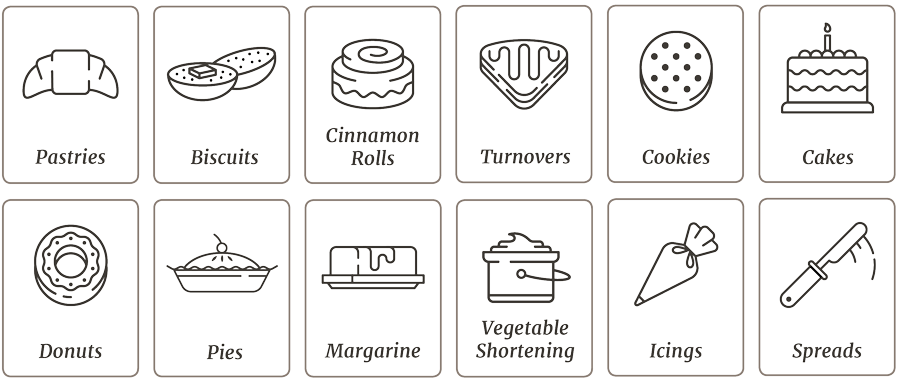
Soy Shortenings: Superior, U.S. Grown Ingredients
Soybean shortenings – including high oleic soybean and conventional soybean shortenings – are proven solutions for a variety of food applications that require solid and semi-solid shortenings.
They benefit food companies with their wide temperature range and excellent melting properties.
For food applications that require high-stability options, high oleic soybean shortening outperforms most other solutions, making it an ideal ingredient.
Soy-based shortenings, which are often developed through interesterification, are U.S. grown, sustainable ingredients. Committed to sustainability, these ingredients are proudly grown by U.S. soybean farmers who make it their mission to protect the land.
Functionality tests show soy-based shortenings are top performers in a variety of bakery applications.

PROCESSING METHODS
INTERESTERIFICATION
Interesterification is a widely used process for producing soy-based shortenings. During this process, fatty acids are rearranged within and among triglyceride molecules, resulting in a wide range of products with performance characteristics similar to those that were produced from partial hydrogenation, such as baked goods.
Desired melting characteristics such as the melting point and melting curves are easily achieved, resulting in shortenings with optimum physical properties to attain exacting texture, mouthfeel and flavor release. Due to the versatility of this processing method, product characteristics and specifications can be tailored to the specific needs of the food producer. Solid or semi-solid soy-based shortenings for a wide-range of applications, such as icings, puff pastries, pies, donuts, cookies, cakes, spreads and more, are readily available.
Processing methods make it easy for U.S. grown soybean oils to be tailored to meet food companies’ specific needs.
BLENDED SHORTENINGS
Blending is another method used to produce soy-based shortenings. By simply combining fully hydrogenated soybean oil with one or more liquid oils, such as conventional soybean oil, high oleic soybean oil or alternative vegetable oils, a wide range of shortenings can be produced. Through varying the amounts of each component, blended shortenings ranging from liquid pourable shortenings to semi-solid shortenings can be achieved.
Blending with high oleic soybean oil extends the shelf life of oil and decreases polymerization.
Fully hydrogenated oils are individual fats and oils, or blends of fats and oils, that are hydrogenated to complete or near complete saturation. Because no trans-fatty acids are formed, fully hydrogenated oils have been approved by the U.S. Food and Drug Administration for use in edible products.
